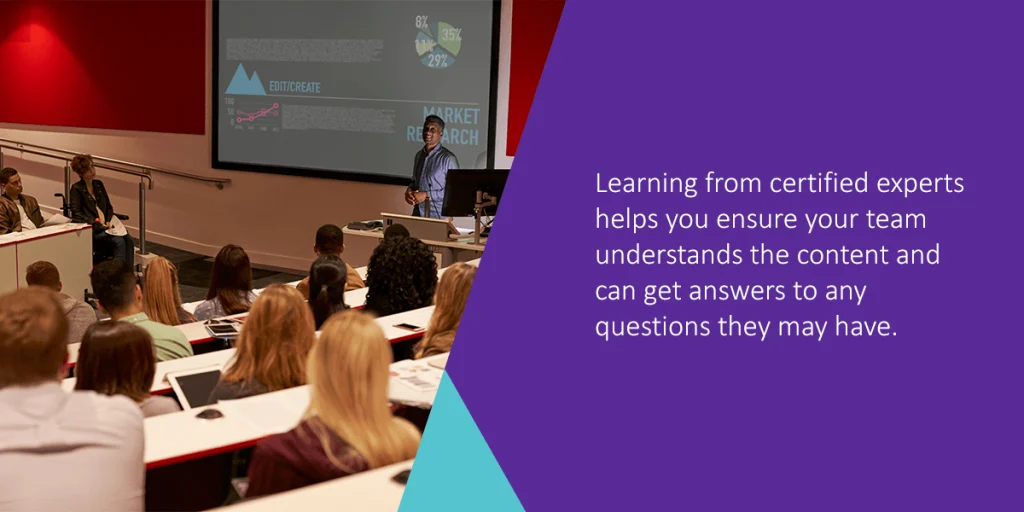




Pulling insights from educational data is a valuable exercise, as it allows you to create actionable steps to help your institution grow and flourish. You can also use these insights to find ways to keep college students involved in higher education.
Now that most U.S. students take at least some of their classes online, there’s a higher risk they’ll feel detached from the educational process, which could lead to apathy and poor student performance. It’s crucial to learn how to keep learners involved and active in their own education, as this will motivate them to excel and increase their overall satisfaction with their university experience.
Figuring out how to increase student engagement in higher education can be complex. But with valuable data and some guiding principles, you can start identifying tangible ways to increase student involvement.
From examining different types of data to establishing a sense of belonging, there are many actions you can take to increase learners’ involvement. Here are six ways to increase student engagement in the classroom and beyond.
One of the first steps you’ll have to take is determining how to measure student engagement. It’s no secret that universities have undergone dramatic changes in recent years, which can make gathering data more challenging. Large-scale quantitative studies can help pull big data together to draw conclusions and build different metrics.
Some effective ways to collect quantitative data include:
You also should remember to look at qualitative data, as this will give you a closer look at the individual experience and remind you of the more personal side of the numbers. Here are some strategies you can use to collect it:
Using these techniques, you can examine research from multiple areas and discover meaningful lessons. The research itself can become a means to involve students in the educational process and make them feel like they’re contributing to something larger than themselves.
Many factors affect student engagement in higher education, so using multiple strategies and software that centralizes the process can be beneficial.
When you use multiple different platforms, communication gets confusing. And these complications can make students and staff feel disorganized and even detached from your institution
Having one central hub of software for all communication benefits everyone. Here’s how:
Any time your institution considers upgrading its tech tools, it’s essential to look for a software provider that offers training opportunities and ongoing support for your staff and faculty beyond the initial implementation process. Learning from certified experts helps you ensure your team understands the content and can get answers to any questions they may have.

Constant communication helps individuals develop bonds and strengthens feelings of engagement among your faculty and students. Recently, communication has faced challenges and experienced many changes in the educational sector, but it’s still essential to keep in contact with organizations. Without modes for getting in contact, organizations can start feeling like they’re on their own and may not have the resources or information available to stay structured and thriving.
Identify relevant communication strategies and find actionable ways to help these organizations. Here are a few things that can be effective in communicating with your student organizations:
Tracking and organizing student organization data can also be very beneficial in seeing how your campus is staying involved and what you can do to increase engagement.
Although some of the remote aspects of education may be viewed negatively, there are significant advantages to adopting technology. One of these is the emergence of community-building programs that take place entirely online. Geographic location is a common reason why many students and faculty members can’t make it to on-campus events.
Virtual events help build a community where people can engage with your campus at their convenience. Giving them the option to attend virtually allows them to be present even if they’re in a different city. You may even see higher attendance rates, which can create that much-needed community environment.
Pulling insights from data can help you to figure out what kinds of events will work for your institution, and you can use that data to build new ways for students and faculty to engage. Large-scale virtual events work great, but remember that traditional, in-person options are always the most important.
While students who feel they belong are more likely to excel in school, it can be all too easy for students to lose sight of their goals and get lost in coursework. That’s especially true of online learning, where students are physically isolated from their classmates and advisors.
Building a sense of belonging both inside and outside the classroom is crucial. Try to cultivate this atmosphere early on so that learners can understand the institution’s culture and begin feeling like a part of it, even before they start the semester. You can help establish this sense of belonging through several approaches, including:
But how can you identify concrete ways to establish this sense of belonging? Use software that streamlines data collection to make synthesizing information as easy as possible, and start uncovering real ways to build engagement with your students.
Recent research has shown that the traditional “one-size-fits-all” approach to higher education serves very few students in reality. For example, nearly half of all full-time students and more than 80% of part-time students work while pursuing a degree. These students often face greater challenges in graduating on time, which can cause them to disengage and drop out.
Personalized learning enables students to take a more active role in their education by customizing their programs to meet their individual needs. Some examples of what personalized coursework might look like include:
Data is the key to unlocking truly personalized learning. You can gather student data using various sources, including student surveys and standardized testing. An integrative software solution that offers a full suite of analytics tools will help you gain actionable insights into that data, which you can use to guide students along a path that works for them as individuals.
Measuring student engagement is one of the best metrics you can invest time into. Engagement relates to student participation, grades, graduation rates, and your school’s overall identity. With today’s remote learning options, measuring engagement and discovering new ways to help your students feel like they belong is becoming even more important.
Analyzing this information can:
Measuring student data will give you swaths of information you can pull real lessons from. You execute the lessons stated above — and even more — just by recording data and interacting with your students and faculty.
You can make the process even easier by finding software that can organize these metrics and display them in a coordinated, streamlined interface. The data you collect should be actionable, meaning you can learn from it and take steps that will make your campus a more engaging, welcoming place. It should also centralize all your data into one location to create a single source of truth for all your operations.
One of the main issues universities face today is stagnation. They may get stuck in old ways and be afraid of change, opting to stick to the status quo for safety. But it’s becoming abundantly clear that for schools to flourish, they must change and adapt to the times, offering new avenues for students to engage with one another and finding creative strategies to increase participation. To start building engagement, you first have to identify where you might be going wrong.
Measuring student engagement can help you see those areas where you may have some issues. Measurement is the first step to correcting and finding a solution. Only then can you fix it and start seeing the results of your actions. Identifying student engagement issues and working toward fixing them will help your school grow and show learners you’re committed to their well-being.
Measuring student engagement will help you uncover issues and build solutions that lead to a multitude of benefits — including improving grades. Research has shown that more student engagement has a positive correlation with students’ grades.
Analyzing your college’s engagement rates can offer you the chance to create the atmosphere needed for more students to exceed and score higher in their classes. Plus, it can improve your school’s overall learning environment. Measuring engagement metrics enables you to craft solutions for multiple aspects of your school.
When evaluating student engagement, you can plan ahead and build cost-effective ways to retain students while also drawing in new prospects. When you create actionable engagement steps from your gathered data, your actions can help current students feel more engaged, and prospects will see the effort put into building a welcoming, engaging atmosphere.
You can spend less time, energy, and money on guesswork and instead invest in concrete methods you know will help overall involvement.
When you’re assessing learner involvement in higher education, you’re doing more than just tracking information and finding methods to help your students — you’re building a culture of continual growth. Your efforts show your school is dedicated to continuous learning and helping students succeed. This is a powerful message to send to current and prospective students, and it can help everyone in your school’s environment stay involved and satisfied where they’re at.
For many students, a strong career is one of the biggest reasons to attend a higher education institution. Many institutions today are offering experiential learning experiences like internships, co-ops, and work-study programs to help students develop the practical skills they need to succeed in their chosen fields — but not all students take advantage of these opportunities.
Offering or expanding practical learning experiences can help boost student engagement by giving students the opportunity to apply what they learn in the classroom to the real world. You can also use student engagement data to determine how satisfied students feel with their program quality overall.
Watermark provides software that can make gathering and organizing data as straightforward as possible. Over the past 20 years in this industry, we’ve gained the knowledge and experience needed to craft innovative software that can help your institution. With a platform that streamlines data collection, we can provide you with the information you need to brainstorm actionable, creative solutions and discover how to increase student engagement in higher education. Request a demo today!






























































































































































































































































































































































































